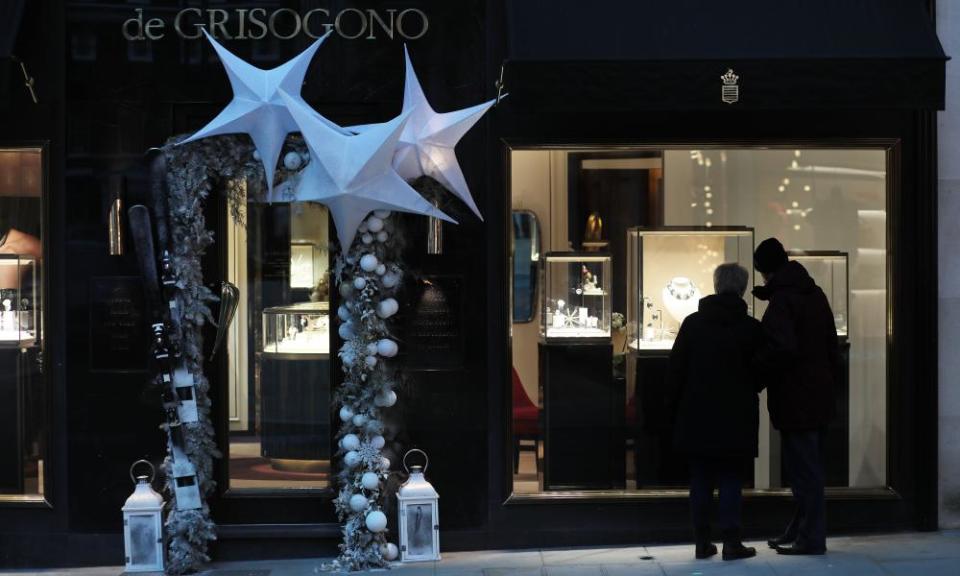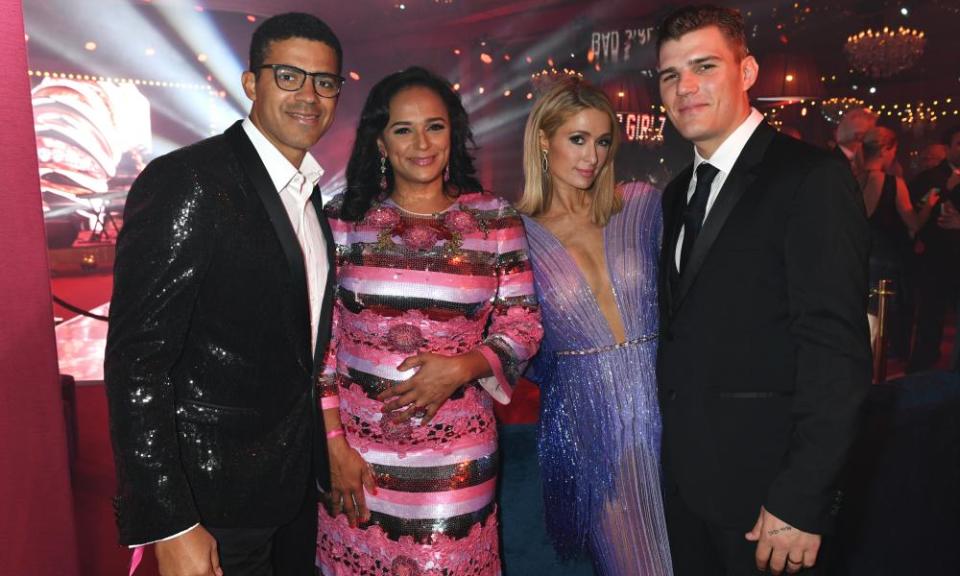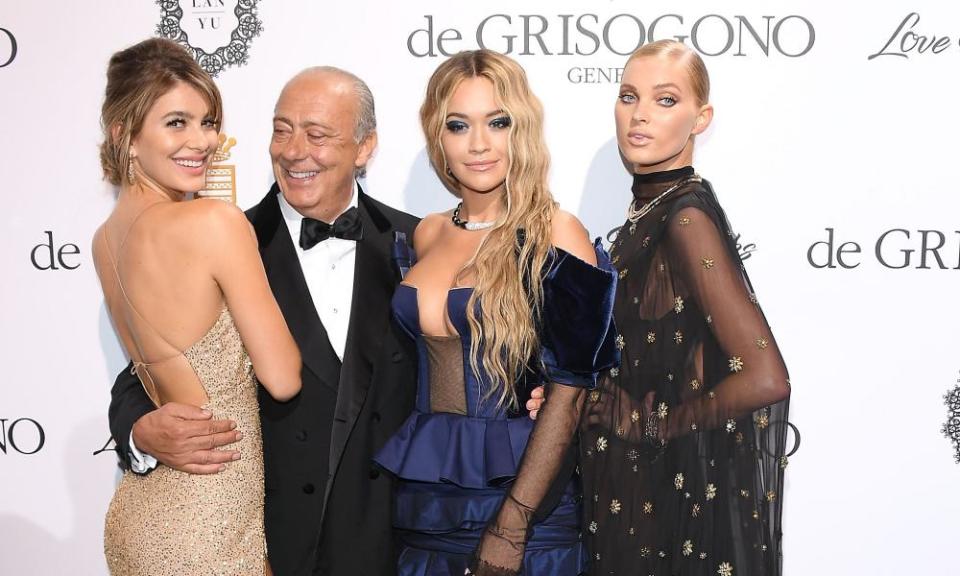The diamond deal that rocked Angola
The jeweller De Grisogono may not be a household name, but it has cachet among the stars. Its annual party at the Cannes film festival is a sparkling occasion, and not just for the A-listers who get to wear the diamond necklaces the company produces.
This is a glamorous world – and one in which Isabel dos Santos, Africa’s richest woman and daughter of the former president of Angola, and her husband, Sindika Dokolo, have had a place since he acquired a stake in the Swiss company in 2012. But this share of one of the world’s most prestigious jewellery makers, and the money behind it, is now part of an investigation in Angola, where prosecutors have said they are looking at allegations that the couple enriched themselves at the expense of the country.
The Luanda Leaks project is based on a trove of 715,000 emails, charts, contracts, audits and accounts detailing the business operations of Isabel dos Santos, the daughter of the former president of Angola.
The files were initially obtained by the anti-corruption charity Platform to Protect Whistleblowers in Africa (PPLAAF), which shared them with the International Consortium of Investigative Journalists (ICIJ).
The documents, which cover a period between 1980 and 2018, have been reviewed by more than 120 journalists from 37 media outlets, including the Guardian, the BBC and the Portuguese newspaper Expresso.
Documents seen by the Guardian suggest the Angolan state-backed diamond company Sodiam was instrumental in buying and financing De Grisogono, exposing itself to huge loans to pay for the purchase of the company and its ongoing support.
But despite its financial investment, Sodiam took no role in deciding how De Grisogono was run. Instead, Dokolo and his team appear to have managed the loss-making business, involving Dos Santos in key decisions such as the establishment and design of new premises in London.

Concern about this arrangement was expressed in an announcement by the country’s new government last month saying it was freezing the couple’s assets, and accusing them of making, and hiding, money at the state’s expense. The decree included a claim that Sodiam is owed $147m for loans used to prop up De Grisogono, money it borrowed from a bank linked to Dos Santos.
It also alleged that Dokolo and Dos Santos were able to buy diamonds from the state at below market value, through several companies that were given the status of “preferential buyer” with Sodiam. The couple have denied the claims and say they are the victims of a political “witch-hunt”.
Related: Isabel dos Santos responds to Luanda leaks investigation
In December, Dokolo launched legal action against Sodiam at a London arbitration tribunal, claiming he had lost $120m in the venture.
The De Grisogono deal is one of many that has been investigated by the Guardian, the BBC and other partners as part of the Luanda Leaks project, coordinated by the International Consortium of Investigative Journalists (ICIJ).
Leaked documents seen by the Guardian and partners reveal a complex set of companies and loans behind the purchase of the stake in the jeweller. The documents, which include company accounts from the years after the purchase and emails describing transactions, offer an insight into the ownership of the Swiss jeweller, and raise questions about why the state invested so much in a loss-making venture while apparently allowing Dokolo to have day-to-day control over the company it was buying.
How Sindika Dokolo and the Angolan state came to acquire a Swiss luxury jeweller
That De Grisogono needed money is one thing that is not in doubt. Despite boasting fans including Naomi Campbell, Sharon Stone and Rihanna, in 2009 it was struggling. Its boutiques in St Moritz and Las Vegas were not ringing up enough sales, and it had bank debts of more than 60m Swiss francs (£50m).
A search for investors to take on the debt and restructure the business led to Angola – source of some of the world’s largest diamonds – and a partnership between Sodiam and Melbourne Investments, a private business ultimately owned by Dokolo. Between them, the documents show, they co-owned two Maltese companies, Victoria Holding Limited and a subsidiary, Victoria Limited. These took over the lion’s share of the jeweller’s Luxembourg parent, DG Holding, and with it the business, and debts, of the high-end brand, buying out an existing debt and paying 3.5m Swiss francs into the company.
On paper, Victoria Holding Limited was a 50/50 venture between Melbourne Investments and Sodiam. Documents suggest that in practice, however, the Angolan state appears to have provided most, if not all, of the funds that made the purchase of De Grisogono possible.
In February 2012, in the days before the De Grisogono deal went through, Sodiam transferred $45m-worth of loans to Victoria Holding Limited, which was used to pay off the jeweller’s debt and provide investment. In contrast, the documents seen by the Guardian do not appear to show any sign of money having come in from Dokolo’s company before the purchase. The first payment from him, of $4m, seems to have come through in early March after the payments for the debt and shares were met.
In a letter, Dokolo’s lawyers said: “It is not correct that Sodiam provided the majority of the funding to acquire the stake in De Grisogono.” They provided no further details.
The potential mismatch in risk appears to have continued in the early years, with papers produced at the end of 2015 stating that Sodiam had advanced $129m while Dokolo had loaned $17m. A draft copy of the shareholders’ agreement from the time of the purchase suggests that Melbourne “has the full control of the management of [Victoria Holding], Victoria Limited, De Grisogono Holding SA and De Grisogono, SA”.

Dokolo’s lawyers said both partners had invested the same sums into the company. “Since the acquisition and until Sodiam’s unilateral withdrawal from the joint-venture in 2018, Mr Dokolo invested about $115m in equity into De Grisogono – verified through an independent audit by a leading global professional services firm and presented to both shareholders. Similarly, Sodiam invested $115m in equity in De Grisogono.”
By 2017, Sodiam’s investmenthad grown to $147m.
It was financed with a loan it took from Banco Bic- an Angolan bank part-owned by Isabel Dos Santos. The debt had an interest rate of 9% and was guaranteed by the Angolan treasury. This suggests Dos Santos’s bank earned interest from the state-backed company but had no risk of losses should things have gone wrong and Sodiam found itself unable to repay its loans.
How Sodiam seemingly came to get the rough end of the stick is part of what the Angolan authorities are investigating. But there is another twist. According to the documents, Sodiam not only paid for most of the couple’s stake in De Grisogono, it might also have unwittingly funded Dokolo’s initial investment.
Shortly before the De Grisogono purchase was arranged, a British Virgin Islands-based company, Almerk International, signed an agreement with Victoria Holding to advise on the acquisition. The document, drawn up in October 2011, said Almerk was a “financial consultant” to Victoria Holding, although “not responsible for giving the company legal, accounting or taxation advice in relation to the transaction”.
It said that for these services Almerk International would receive a success fee. What was not stated in the agreement, or apparently disclosed to the auditors of Victoria Holding, is that Almerk International was owned by Dokolo. Immediately after the deal went through, Almerk received $4m from Victoria Holding for its services. Days later, the money appears to have been paid back to Victoria Holding by Melbourne Investments.
It would appear that Dokolo’s investment in Victoria Holding, and ultimately De Grisogono, was in effect paid for by Sodiam.
Giving a different figure, his lawyers said: “For the successful complex negotiations and structuring of the acquisition of De Grisogono, which included buying back the company’s bank debts in Switzerland at a significant discount resulting from a payment of only CHF [Swiss francs] 25.7m of the CHF 63.5m outstanding, Mr Dokolo, through his company Almerk, received a remuneration fee of $5m.”
Tom Keatinge, the director of the Centre for Financial Crime and Security Studies at the Royal United Services Institute, said there were questions over the involvement of Almerk and the “circular movement of funds”.
“It seems a bit odd to work as an adviser or consultant on a deal which you are going to benefit from. It’s not illegal but it just doesn’t look good.”
He added: “This is not a zero-risk proposition, but who is bearing the risk is the question. We can say that the bank is not bearing the risk, because it has the guarantee from the state. Dokolo is bearing the risk, but he has an influential connection with Sodiam ... The question is what would have happened if it started to go wrong – how would Sodiam have reacted?”
Just months after De Grisogono held a “Love on the rocks” Cannes party in 2017, the relationship between the shareholders was disintegrating. The business was losing money, with a turnaround plan and big-budget spending on marketing failing to have much impact on sales and profits.

Late that year, shortly after Dos Santos’s father, José Eduardo dos Santos, stepped down as president of Angola, the new leadership of Sodiam announced it wanted to withdraw from De Grisogono for “reasons of public interest”, although it still holds its investment.
Sodiam’s new chairman, Eugénio Pereira Bravo da Rosa, said the loan taken out from Banco Bic had grown to almost $200m with interest. He said the government was awaiting the results of an audit of Victoria Holding and De Grisogono, carried out by PwC. “It is legitimate to consider that we must pursue all options with regards to recuperating this money,” he said.
Dokolo has denied this description of events. He told Radio France Internationale: “The debt that was contracted by Sodiam to make this investment was … in kwanza [Angola’s currency]. Today what it owes to the bank is the equivalent of $20m … It’ s just populism to say that because of this investment Sodiam is in a state of near bankruptcy.”
Accounts for the companies involved in the De Grisogono purchase do not show anyone getting rich from it. There are no huge dividends or high interest rates paid to Dokolo’s companies. But the couple do seem to have enjoyed some of the trappings of ownership of such a prestigious jeweller, attending celebrity parties at Cannes and buying gems on credit.
Da Rosa said the state had expected to make money from the investment in the Swiss jeweller but instead the taxpayers of Angola had been left with a $200m bill.
“What really happened was that … from the time that the participation of Sodiam was signed, the state has not profited one single dollar,” the Sodiam chairman told the ICIJ partner BBC Panorama.
Da Rosa said there were indications that the deal was “not done with the proper transparency”. Asked if he believed that there was corruption in the business, he said: “What do we understand by corruption? To use political influence, to use a certain channel to obtain advantages? If that is how we understand it, then I believe so.”
Dokolo’s lawyers denied “allegations of nepotism and corruption” that “simply parrot the politically motivated allegations from the current Angolan government”.
The $34m necklace
Weighing in at 163.41 carats, a diamond-set De Grisogono necklace made headlines when it was auctioned for $34m in 2017. Hewn from a 404-carat Angolan rough diamond, the gem’s cutting and setting had been personally overseen by De Grisogono’s founder, Fawaz Gruosi, in a process breathlessly described in the auction catalogue.

The fairness of sales of Angolan diamonds such as this is now in doubt after state prosecutors alleged that under the previous regime, Sodiam had been instructed to offer them at below market value to “preferential buyers” related to Isabel dos Santos and her husband. The prosecutors claim these companies were able to keep the profits from the sales, while the Angolan state lost out.
In a letter, Dokolo’s lawyers disputed the allegation, and said one of his companies had, in fact, paid more than market value for jewels.
“In part to ensure a sufficient supply of high-quality diamonds for De Grisogono, the company Relactant became a preferential buyer to purchase rough diamonds and Relactant agreed to pay an above market rate of an additional 5% as goodwill for Sodiam.”


